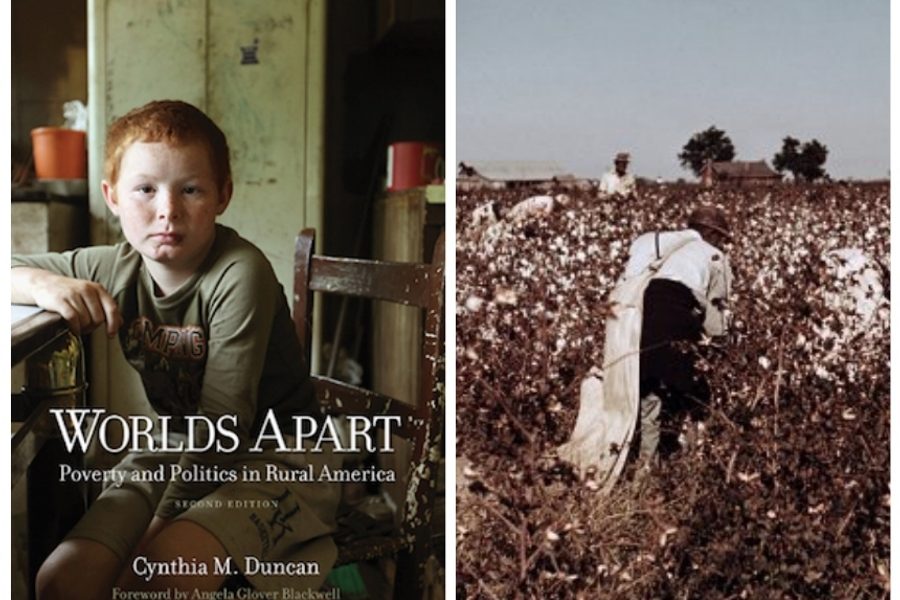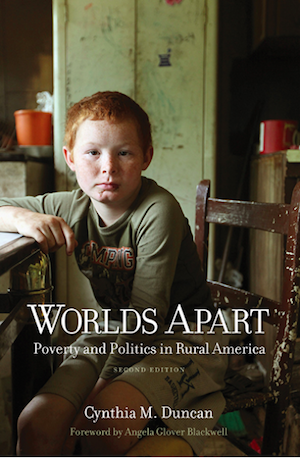Creating and Maintaining the Plantation World in the Mississippi Delta
Cynthia M. Duncan

Mississippi’s Yazoo Delta was settled in the 1830s by wealthy planters from other areas in the South who had the resources to clear the swampy, snake-infested land and buy slaves to cultivate cotton in the fertile soil. Historian James Cobb describes a socially and economically ambitious group of Delta planters who pushed their slaves hard, year round, so that they could live ostentatiously themselves. He says their ability to maintain their decadent conspicuous consumption and to meet the economic requirements of growing cotton in this harsh environment “was wholly dependent on their success in retaining and controlling a large supply of black labor.”
Immediately following the Civil War, the planters experienced a period of labor shortages as both blacks and whites adjusted to a social and economic world without slavery. During this time some blacks rented farm acreage and others were even able to purchase marginal land that required clearing. The forebearers of some black families in Dahlia benefited from this narrow window of opportunity. The window, however, was soon closed. By the 1890s, with federally financed levees and privately financed railroads ensuring their place in the national economy, Delta planters once again had complete control over their workers. More black farmers came into the region as cotton plantations grew and workers were needed to build the levees and railroads, effectively ending plantation owners’ worries about labor shortages. The planters adopted modern, manufacturing-style management techniques and, as part of this strategy, reestablished firm control over their workers.
They also benefited from growing restrictions on blacks’ political rights. As Cobb concludes, “Changes in the economic and demographic conditions in the region during the 1880s triggered a sharp decline in overall fortunes of blacks and set the state for the legal and extralegal measures whereby whites regained control over black workers in the Delta … If the events of the 1880s and 1890s ultimately helped to seal the gloomy fate of the Delta’s black laborers, they had precisely the opposite effect on the fate of its planter elite.” By the turn of the century the planter elite had diversified into other economic endeavors, reinforced its political control, and reached out for both public and private capital to feed the region’s growth. To maintain their profits and extravagant lifestyles they needed the low labor costs they could derive through rigid control over their black field workers.
Between 1900 and 1930 opportunities and options available to black workers in the Delta were further eroded by disenfranchisement. Most continued to live on the plantation, subject to economic and social controls, whether their status was laborer or sharecropper. In arrangements virtually identical to those in the coal fields, they were often required to buy supplies at the plantation commissary, and most needed a cash advance furnished by the planter during the winter months when there was no work. These patterns were documented in histories of the 1920s and 1930s. As one historian put it: “Tenant farmers and sharecroppers acted as economic shock absorbers for landowners and planters. Many tenants never made a profit and succeeded only in going deeper and deeper into debt from year to year. Landlords kept the books and managed the sale of crops. Opportunities for exploitation were increased by the high rate of illiteracy among tenants and sharecroppers.” While tenants often moved from plantation to plantation — some say because the only way they could protest bad treatment was to move — the terms on any given plantation were likely to be the same. Delta planters were concerned about losing their labor during the first Great Migration of blacks northward before and during World War I, but they managed to retain complete power of those who remained. Importantly, that control was over every aspect of life — economic, political and social.
During the 1930s, psychologist John Dollard and sociologist Hortense Powdermaker documented the rigid class and caste stratification imposed by white planters. They showed that planters maintained their complete domination over black laborers and sharecroppers not only in their workplace but also in crucial social institutions. Planters controlled all credit, stores, and housing. Whites blocked poor black workers from their schools because they feared educated blacks might challenge their hegemony, but tolerated black churches because during this period churches mostly reinforced, rather than challenged, the status quo.
During the 1950s and 1960s, the effects of the second Great Migration to Chicago and other northern cities swept these Delta communities. In the 1960s minimum wage laws were imposed and planters reacted by introducing mechanization to save on labor costs. But they still kept tight control over those laborers who continued to work on the tractors, in the fields, and in the cotton gins. National welfare programs established by the federal government were tightly controlled and manipulated by the elite, who ensured that the benefits reinforced rather than undermined their absolute control over the livelihood of those who remained. As Cobb showed, they were able to make federal assistance available to black families when there was no work in the field, and then have it withdrawn when they needed workers. He concluded, “Although the cumulative influences of the New Deal and World War II brought dramatic changes to the Delta’s economy, the transformation of Delta agriculture left the region’s planter-dominated social and political framework fundamentally intact.”
Despite the danger of repercussions in these small, segregated communities, some blacks took part in civil rights demonstrations during the 1950s and 1960s — and most often found themselves blackballed from work as a result. Cobb recounts how all those who signed a National Association for the Advancement of Colored People (NAACP) petition in favor of school integration lost their jobs. The relentless and devastating punishment white employers could inflict on blacks who supported civil rights forced the NAACP to be less outspoken in rural areas. Dahlia’s NAACP, like the NAACP groups Cobb researched, came to represent “a conservative, middle class orientation.”
Not all whites, of course, were part of the blacklisting and resistance to civil rights, but the tone was set by those who wanted no part of integration. There was fear and resistance to change by whites. A young professional woman in Dahlia recalled that her father, a physician, had insisted that his children stay in the house for a week when Martin Luther King was killed. He told them things were going to change. I remember that year, in the forth grade, my father telling me, “You can’t use the word ‘nigger’ anymore.” We used it pretty loosely. I knew as a child it was a derogatory comment and to be polite you used “Negro” — if you can understand the distinction.
Across the nation, the decade of the 1960s was a period of rural industrialization, when manufacturing plants moved from America’s increasingly troubled urban industrial areas to job-hungry rural communities where workers accepted lower wages. Cobb describes how whites in the Delta would make sure that factories interested in their communities would have no qualms about hiring only white workers. Both whites and blacks can cite specific examples of factories interested in locating in Dahlia being turned away by planters. Some acceptable factories — like the blue jeans factory — came in after they agreed to hire blacks only as janitors. Many Dahlia residents think the opposition to industry persists. As one white leader put it, As long as the farmers’ power structure is there, they’re not going to let industry in. They blocked it before and they’ll block it again.
Dahlia saw significant out-migration in the 1950s and 1960s: almost half the population left the region in these decades. Those who remained often relied on a combination of part-time and part-year minimum wage work and welfare programs. Despite the out-migration and the decline in farm labor, planters continued to maintain tight, even ruthless, control over economic and political life, ensuring the continuity of their privilege and power into the 1970s. When integration threatened the well-established caste system, whites set up separate private institutions to replace public ones — schools, recreation facilities and clubs. These separate worlds persist to the present.
In 1930, when the grandparents of the twenty-, thirty-, and forty-year-olds I interviewed were in their prime working years, 90 percent of all employed people in Dahlia worked in agriculture. Nearly all 125 black men and women whom my colleagues and I interviewed, poor and nonpoor, had grandparents who “worked on a farm.” This concentration in farming declined gradually over the next several decades, and by 1960 about two thirds of all work was in agriculture.
The demand for workers changed dramatically in the 1960s, when mechanization replaced hand picking of cotton, crop reduction programs of the Department of Agriculture further reduced the need for workers, and minimum wage laws pushed by the planters to introduce greater labor efficiency. By 1970 only one fourth of all workers in Dahlia were in agriculture. In 1990, the official census statistics showed that only 16 percent of all workers were in agriculture or related industries; manufacturing now provides employment for a quarter of all workers. These statistics may understate farming’s role today because they miss many part-time workers who “chop cotton” — or weed the cotton fields — in the summer, but they are indicative of the scale of change. When the 1960s began, there were still 30 to 40 families working on every two-thousand-acre plantation. Today those farms can operate with five or six men, most of them seasonal workers.
As the structure of the economy changed, people adapted by moving away to seek work elsewhere. Between 1930 and 1990 the population of Dahlia shrank from over 45,000 to around 20,000, while the number employed dropped from nearly 28,000 men and women to just 6,000. Every black person I interviewed had relatives who had left the Delta for northern and midwestern cities, as well as a few southern cities like Birmingham, Memphis, Little Rock and St. Louis. Usually at least half of the siblings in a family would be gone. Many poor men and women now in Dahlia have lived elsewhere at some point but returned home when things did not work out.
The 6,000 working men and women in Dahlia have jobs in stores, government offices and schools, on farms, in sewing factories and electrical assembly factories, in catfish plants, and, very recently, in gambling casinos. In 1990, 1,500 white men and 1,800 black men were employed, as were 1,200 white women and 1,200 black women. Blacks have more difficulty finding work. Only about half of black working-age males are employed, compared with two thirds of whites, and only one third of black women are, in contrast to nearly half of white women. About half of working black males have only part-time or seasonal work.
Whites run the plantations, do the white-collar and managerial jobs, and present the face seen by the public in stores and businesses. When a job comes open, those doing the hiring call people they know socially to see if they are interested, just as happens in Blackwell. People describe a hiring process that operates by invitation only — in schools, in welfare offices, in banks, and in stores. So-and-so called me and said, “Are you interested?” The same process occurs for those from the handful of black establishment families.
At the same times, the farmers’ ability to get people hired, and fired, is widely accepted. These farmers could say “well, he’s worth hiring” and they’ll hire you. That’s all you have to do is have one of the farmers say something about you and that’ll be it because you’ll get the job any place. Even in a store or something.
Blacks who dropped out of school or only finished high school work in fields and factories, while the few who have a college degree are likely to work in the schools and public offices. Even with the factories, many black women still work as domestics — although these workers often do not appear in official statistics. Jobs in the fields are seasonal — their peak is April to November — and during the winter months the farm managers go duck hunting and the farmworkers get unemployment checks and food stamps. Jobs in sewing factories fluctuate as well, as managers lay off and hire to make production accommodate the “just in time” demands of their big retail customers. A plant with 300 employees may let 50 of them go when orders are low in the spring. Managers of factories, where more than 80 percent of the workforce is black today, have as many applications on file from people seeking work as they do jobs in their plant. A new local take-out food business recently had 150 applicants for 17 new jobs. Jobs are scarce is a constant refrain among blacks in these Delta counties, just as it is among the have-nots in Blackwell.
A Dahlia businessman explained that he needed to hire blacks because whites would not take the kind of work he had — part-time hard labor. My employees are colored men. I don’t work anything but black because most of my business is part-time. I can’t afford to pay someone a monthly salary year round because we have a seasonal business. The whites are going to need more work that I’m not going to be able to give them.
A political and business leader lamented the passing of the days when blacks were doing more fieldwork. It’s good to have those jobs and good menial labor. There are people who say, “just get the equipment and don’t do any more hand labor.” But I think hand laboring teaches the value to life — to production. Older whites express the same view, saying it is good that the farmers are hiring more people to chop cotton since it provides much-needed work and discipline. Black men and women who have chopped describe brutally hot, exhausting, long days, cotton stalks hitting you upside the head, and many blacks in their teens simply refuse to take the work.
CLASS AND CASTE IN THE DELTA
The social class structure reflects racial stratification — almost all the whites in Dahlia have economic power and security, almost all the blacks are poor and powerless. Around two thirds of whites have a high school degree or more, compared with one third of blacks. Nearly a fifth of whites have completed college, but only about four percent of blacks have. These patterns of inequality were established long ago to meet the economic needs of a plantation economy, and they have been deliberately, and on occasion ruthlessly, maintained to preserve white power and affluence in a black-majority area.
At the bottom of the social structure are the black poor — many of whom work at least part of the year, even if they receive public assistance. At the top are the big farmers and their families, followed by their anxious lieutenants — the shopkeepers and politicians who control jobs and small-time politics as long as they do not challenge the status quo. People in this next echelon of whites — those with neither land nor great wealth — see their interests as best served by allying with the wealthy farmers; they keep themselves separate from the poor, preserving a segregated system that ensures their own comfort and status. Finally, there is the small, changing black leadership group, made up of the few black households with middle incomes (in 1989, 3 percent of black households earned between $35,000 and $75,000).
The black working poor in these Delta counties grew up in hard circumstances out in the countryside on plantations — some black leaders call them “first generation,” meaning first generation to move off the plantation; some whites, as we saw, call them “agricultural blacks” or “cotton patch children.” They invariably refer to themselves as “country,” and as adults they still struggle to overcome what growing up poor in the country has meant for them. Caroline Gage’s story illustrates how isolation and lack of even minimal resources make the Delta poor vulnerable to a lifetime of insecurity, while James Hill’s and John Cooper’s experiences show the deep and pervasive influence of the bossman on black men’s lives in the Delta.
Caroline is a 34-year-old single mother who supports herself and her five children by combining work in a sewing factory, house-cleaning, and public assistance. She lives in Tall Pines, the Farmers Home Administration development with single-family homes, in a sparsely furnished three-bedroom house with a combined kitchen and living area. Her possessions are old things she has refurbished — a rusty refrigerator covered in floral-patterned sticky paper she found on sale, an old couch with a bedspread thrown over it. She is always battling to rid the house of rats and roaches.
The neighborhood is rough — young men in Tall Pines use knives and sometimes guns to fight with their counterparts in Old Town. Crime and drug use are high, and most yards and houses are run down; many have bars on the windows and doors. Caroline would rather live somewhere else. Staying out here is like staying right under somebody, she says. On weekends, they always be standing on the corner and they bust bottles and all that kind of stuff in your yard. They throw paper. Every week we have to clean the yard. We have to pick up beer bottles and glass which they have broken in the yard. Dishes, old paper, cans, and that sort of thing. I just don’t like it. I had to move back here because I couldn’t find any other place to go, but I don’t like it.
An excerpt from Worlds Apart: Poverty and Politics in Rural America, Second Edition, by Cynthia M. Duncan, published by Yale University Press in 2015. Reproduced by permission.

*Statistics cited in this section were gathered in the 1990s for the first edition. Counties and interview subjects were given pseudonyms.





